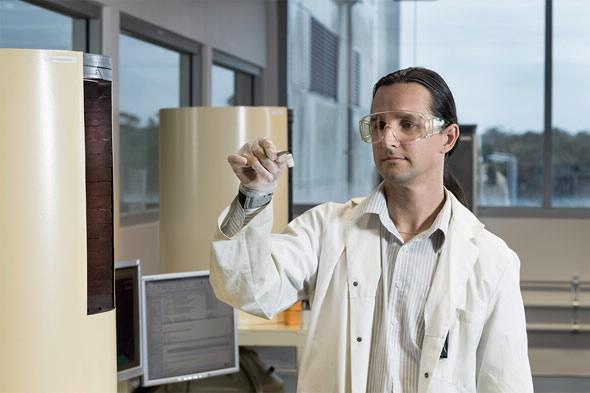

Published on the 23rd November 2016 by ANSTO Staff
ANSTO is contributing to a significant international collaboration conducting independent experiments to redefine the fundamental measurement of the kilogram.
The base unit of the kilogram is currently defined by a physical object, a cylinder of platinum-iridium alloy, known as the International Prototype of the Kilogram (IPK) or “Le Grand K”, which is kept in a sealed vault in Paris.
A series of replicas of the object (see below right) are kept in locations around the world including one at the National Measurement Institute in Lindfield, NSW.
One key experiment, the International Avogadro Project, involves determining the number of atoms in a single crystal of silicon-28 in the form of a highly polished and extremely round sphere by measuring the volume of the atomic unit cell and the overall volume of the sphere.
Metrologists previously identified that there was a problem with the Le Grand K, because its mass, which is meant to be unvarying, was found to be lighter than its copies. Causes of these discrepancies in the measurement have not been firmly established but are thought to be due to the ageing of the cylinder.
The reliability of the measurement is essential for scientific and industrial applications around the world.
A new definition that is linked to a fundamental constant of nature, Planck’s constant, does not increase the precision of the measurement but is expected to ensure long term stability.
There are many components in the initiative which are being shared by institutions around the world, including the National Institute of Standards and Technology (US) and the Bureau International des Poids and Mesures (France) among others.
The total number of atoms is a measurement of Avogadro’s constant (6.02214082(18) × 1023 mol-1), the number of constituent particles in one mole of a substance, is used to calculate the Planck constant (6.62607004 × 10-34 m2 kg /s), the energy of a quantum of electromagnetic radiation divided by its frequency.
A more precise definition of Avogadro's number strengthens the definition of Planck's constant, the value that will set the size of the kilogram.
Neutron activation analysis (NAA) at OPAL’s multi-purpose reactor was undertaken to measure trace impurities in silicon, which is 99.99 per cent pure.
“NAA is a highly sensitive method of determining elements that are present in a sample and was the best way to confirm the purity of the silicon isotope,” said Neutron Activation Scientist, Attila Stopic.
The Italian National Institute of Metrology Research (INRiM), needed access to the OPAL reactor for the neutron activation analysis of the silicon.
 |
| Neutron Activation Scientist Attila Stopic demonstrates how samples are inserted for gamma spectroscopy following irradiation with neutrons |
The samples were brought to Lucas Heights by INRiM researchers for the irradiation and to exchange expertise.
“Unlike most of our samples which tend to be 50 or 100 milligrams, we were working with 14 grams,” said Stopic.
NAA is a technique which makes specific elements radioactive, causing them to emit a gamma signal.
The irradiation in the reactor pool lasted five days. Following irradiation, the samples were analysed using gamma spectrometry to allow trace quantities of elements other than silicon to be determined and quantified.
“The impurities, which occur in only incredibly low levels, are detectable and measurable because silicon-28 is invisible using this technique,” explained Stopic.
“The laboratory is pushing for 100 per cent purity.”
 |
| The new silicon sphere used in experiments to redefine the kilogram Photo credit: NIST |
The International Committee for Weights and Measures (CIPM) has recommended that three independent measurements using two different methods of Planck’s constant agree before using the value to define the kilogram.
Another experiment uses a watt balance to determine the value of Planck’s constant. The experiment compares a force generated by the current in a coil sitting in a magnetic field with the weight of a mass.
NAA measurements at the OPAL reactor are ongoing.
The kilogram base unit, as part of the International System of Units, will be reviewed by the CIPM in 2018.
Watch the Veritasium video which described the project and the production of the sphere
Read more in Science News